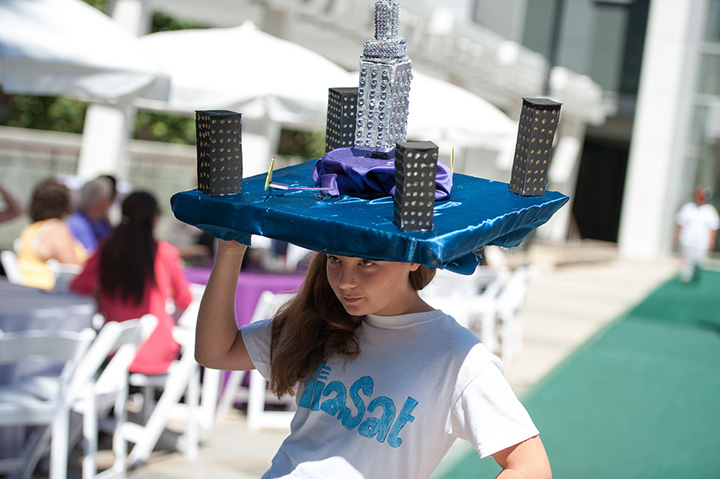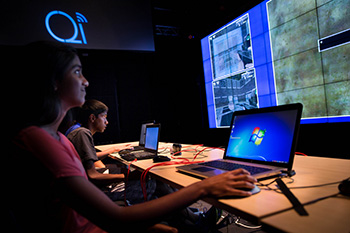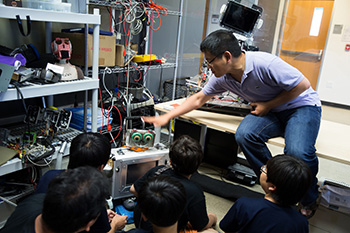
Summer of Science Engages K-12 Students
By:
- Tiffany Fox
Published Date
By:
- Tiffany Fox
Share This:
Article Content

One of the participants in the Qualcomm Institute's Robot Hat Day program shows off the animatronic hat she created by learning how to program and Arduino microcontroller.
It’s not unusual for heated scientific debates to break out at the University of California, San Diego’s Qualcomm Institute. But nine-year-olds arguing about the history of aviation? That’s a little more unusual.
The young students were visiting the Qualcomm Institute—the recently named UC San Diego division of the California Institute for Telecommunications and Information Technology (Calit2)—as part of a tour arranged for the Elementary Institute of Science (EIS). EIS is a summer camp for elementary and middle school students interested in the STEM fields —(science, technology, engineering and mathematics) and 60 EIS students descended on Atkinson Hall Aug. 9 to see the technologies, laboratory spaces, projects and datasets for interdisciplinary STEM research in action.
The institute works closely with other groups on campus to showcase the excitement of research to hundreds of K-12 students each summer. They come to campus for first-hand experiences in residential or day programs. The EIS students were part of an immersive program organized by the Jacobs School of Engineering’s IDEA Student Center.
During a demonstration of the institute’s Vroom large display wall (which was being used to ‘walk through’ historic layers of Leonardo da Vinci’s “Adoration of the Magi” painting in high resolution), a few of the EIS students launched into a surprisingly detailed historical analysis of Leonardo’s inventions, including the artist’s designs for a glider. (Student Ryan Trust noted that Leonardo often wrote in his diaries backwards so “no one would steal his ideas.”). The discussion got so involved that tour leader Sean Estelle, in the interest of time, had to intervene by agreeing that the glider was one step in an evolution of technologies to see if man could fly.
Nine-year-old Avery Bryant couldn’t resist making one last point: “Wait a minute—if they thought men could fly, wouldn’t that also mean ladies could fly, too?”
Avery could one day be eligible to participate in one of the Qualcomm Institute’s signature youth programs: Robot Hat Day. It’s organized by the institute’s MyLab outreach group, led by UCSD alumna Saura Naderi. Over the course of six weeks, girls come to campus twice per week to learn about robotics and the basics of programming Arduino microcontrollers. In previous years, students aged 7 to 16, all from low-income neighborhoods, could join. In 2013, the program was modified to focus on 14- to 16-year-old girls, making it easier to teach everyone at the same general level.
For many of the girls, the program is their first taste of engineering, guided by alumni and undergraduate volunteers through the process of constructing animatronic hats from the microcontrollers and an assortment of fabrics, toys, costume jewelry and other accoutrements. This year myLab director Naderi worked with the local chapter of BeWISE (Better Education for Women in Science and Engineering) to recruit the girls, who presented their creations in a runway show on Saturday, August 17.

Neesha Chockalingam and Hersh Gupta play the video game they created this summer using both HAXE and FBS creator coding languages.
“What really surprises me about some of the girls is that they take fabric and materials and manipulate them into something entirely new,” said Naderi. One of the girls in this year’s program, for example, took a piece of artificial turf, turned it over and noticed that the underside looked like alligator skin. That piece became an alligator on her zoo-inspired hat, which also featured creatures she fashioned from felt and pipe cleaners.
“It’s proof that you cannot underestimate or neglect the female population when it comes to STEAM fields,” added Naderi, adding the extra ‘A’ for art. “If these girls are repurposing materials to make a hat, what would happen if they started working with circuits? These girls don’t know what they don’t know, so it just goes to show how having a diverse background can create a diverse set of solutions.”
Summer 2013 also marked the start of a new program for high school students in collaboration with UC San Diego’s partner schools. Teachers from three local high schools were invited to recruit juniors to be part of the Qualcomm Institute’s High School Summer Scholars program. Until now, only undergraduates were allowed to be QI Scholars, but the institute decided to provide the selected high school students with paid internships to work in labs on campus—often mentored by the 2013 undergraduate scholars, as well as by grad students and faculty members or QI researchers.
The inaugural class of High School Summer Scholars totaled 11 students—nine from Gompers Preparatory Academy, one from Lincoln High School, and one from the UC San Diego Preuss School. Lincoln High’s Stephanie Barrera worked in the lab of Bioengineering professor Todd Coleman. Preuss School student Mare Diaz worked in the Nanoengineering lab of Darren Lipomi, and benefited from working alongside two undergraduate Calit2 Scholars, Herad Moetazedi and Ester Chan. From Gompers, Gresia Perez worked with undergrad Cory Heath in the Electrical and Computer Engineering lab of professor Shadi Dayeh, while other students from Gompers worked with Nate Heintzman from the School of Medicine, or Qualcomm Institute staff engineers Daniel Johnson and Anthony Nwokafor.
The High School Summer Scholars program ended officially Aug. 22. Some of the students, however, may be back on Sept. 19 to participate in the annual QI Scholars poster session – as long as they can get the day off from school. If they do, some of them will get to see their names published on the undergraduates’ posters—an honor that most students in STEM fields don’t typically get to enjoy until graduate school.
The four-week residential science and mathematics program known as COSMOS is another of the Qualcomm Institute's efforts to reach out to high school students. The program, which is managed by the Jacobs School of Engineering, enlists faculty and tafff from QI each summer to instruct one of eight disciplinary 'clusters.' This year, Ryan Kastner of the QI Explorers for Engineering program (and the UC San Diego Computer Science and Engineering department) oversaw a cluster called "Computing for Everyday Life," with assistance from QI's Curt Schurgers and Saura Naderi. Many of the undergraduate mentors for the students in the COSMOS program were also recruited from the Explorers for Engineering program, which provides support for hands-on engineering projects that further worldwide exploration.

QI robotics researcher Tingfan Wu shows the RUBI robot to elementary students visiting as part of the Robolink program.
The Qualcomm Institute has been particularly keen to host visiting students from underserved areas of San Diego County. Most of the summer scholars came from disadvantaged neighborhoods, as did many of the 40 students from Oceanside and El Camino High Schools who toured the institute as part of the ARC program, a service-based corporation that provides after-school and experiential programs for youth. Greg Johnson, an ARC staff member who coordinates ARC’s Leadership, Experience, Adventure and Development (L.E.A.D.) program, says the tours and demos the ARC students participated in “opened their eyes to how fun science can be.” “They got to see technologies before they’d be exposed to them in the real world,” he added. “That opened their eyes to what they can do in college.”
Encouraging students to get a jump on a college education is one of the primary goals for the Qualcomm Institute’s outreach efforts. The summer scholars were exposed to seminars on how to present their research, write resumes and interview for jobs. During a panel presentation that the High School Summer Scholars gave for their peers in the ARC program, several of the students expressed an interest in attending UC San Diego as undergrads.
Ashley Diaz Rodriguez, a student from Gompers, spent the summer working in Coleman’s bioengineering lab and called it “a life-changing experience.”
“Not only did I learn the basics of working in a laboratory, but I also made friends for a lifetime,” she said. Todd Coleman's lab allowed me to grow with them all this summer and have a wonderful experience collaborating with them. My experience has changed the career path I'd like to pursue in the future. I learned to live fully and do something I enjoy. If I could do the internship all over again, I would and I would not change a thing about it. I'm thankful to God I was blessed with this opportunity.”
The institute also organizes informal programs for high school students, including unpaid internships and seminars such as the crash course in how to develop a video game taught by Qualcomm Institute principal development engineer Ganz Chockalingam. His daughter Neesha wanted to learn the basics, so Chockalingam offered to mentor a small team of four students. The 8th to 10th graders spent several weeks designing 2D and 3D games using development tools like Stencyl and FPS Creator.versions of a first-person-shooter game, using both the HAXE and FPS creator coding languages.
On Aug. 20, the students—Hersh Gupta, Vishrut Gupta, Josh Jacobs, and Neesha Chockalingam, the only girl on the team—did a live demo of the as-yet-unnamed game in front of Qualcomm Institute director Ramesh Rao and an audience of parents and siblings. Josh provided a running commentary about the game’s bells and whistles as he navigated his player through a labyrinth of ominous-looking rooms and industrial elevators. The lone girl on the team chose to hide rather than shoot to play—“the boys always kill me right away” she demurred—but she was nevertheless proud of what the team accomplished in a few short weeks. All of the students must have had college in mind as they designed the game: it takes place in a fictional, alien-like version of the UC San Diego campus.
The kids got an excellent introduction to the various facets of game programming, such as map creation, sprites, 3d modeling, collision detection and physics,” said Ganz Chockalingam. “ For them the biggest thrill was to play a game they created.”
Michelle Ferrez, director of the Jacobs School of Engineering IDEA Student Center (which partnered with EIS on the student tour and often collaborateds with the Qualcomm Institute), says the educational outreach conducted by the institute and the Jacobs School are integral for not just recruiting students to the university, but also for creating a lifelong love of science and technology.
“We’re concerned not only about getting students engaged with these fields of study, but it is also about engaging them early and often,” said Ferrez. “Outreach initiatives need to be purposeful—programs that provide enrichment and familiarize students with what engineers do can influence a student's choice of career. Through hands-on activities and interacting with engineers, you make engineering fun, relatable, and you are delivering content and skills in ways they can understand. Depictions of science, engineering, and technology are more present than ever before. Thus, enlightening students about the importance of science and technology to society and creating opportunities for expanded understanding of the role of science and engineering in their everyday life is meaningful and impactful."
And if the Qualcomm Institute can attract high school students to that pipeline with programs like the ones offered over this summer, some of those students could one day return to the campus as scientists, engineers or artists – and as mentors to tomorrow’s high school students.
Share This:
You May Also Like
Stay in the Know
Keep up with all the latest from UC San Diego. Subscribe to the newsletter today.


